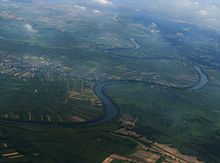geo.wikisort.org - River
The Kupa (Croatian pronunciation: [kûpa]) or Kolpa (Slovene pronunciation: [ˈkóːlpa] or [ˈkóːwpa]; from Latin: Colapis in Roman times; Hungarian: Kulpa) river, a right tributary of the Sava, forms a natural border between north-west Croatia and southeast Slovenia. It is 297 kilometres (185 miles) long,[2] with its border part having a length of 118 km (73 mi)[1] and the rest located in Croatia.[4]
| Kupa / Kolpa | |
|---|---|
 Kolpa at Prelesje (Slovenia) | |
| Location | |
| Countries |
|
| Physical characteristics | |
| Source | |
| • location | Razloge, Gorski kotar, Croatia |
| • elevation | 313 metres (1,027 ft) [1] |
| Mouth | |
• location | Sava, Sisak, Croatia |
• coordinates | 45°27′36″N 16°24′08″E |
| Length | 297.4 km (185 mi) [2][3] |
| Basin size | 10,226 km2 (3,948 sq mi) [2] |
| Discharge | |
| • average | 283 m3/s (10,000 cu ft/s) |
| Basin features | |
| Progression | Sava→ Danube→ Black Sea |
Name
The name Colapis, recorded in antiquity, is presumed to come from the Proto-Indo-European roots *quel- 'turn, meander' and *ap- 'water', meaning 'meandering water'. An alternative interpretation is *(s)kel-/*skul- 'shiny, bright', meaning 'clear river'.[5]

Course


The Kupa originates in Croatia in the mountainous region of Gorski Kotar, northeast of Rijeka, in the area of Risnjak National Park. It flows a few kilometers eastwards, receives the small Čabranka River from the left, before reaching the Slovenian border.
It then continues eastwards between the White Carniola region in the north and Central Croatia in the south. The Kupa receives influx from the river Lahinja from the left in Primostek, passes Vrbovsko, and eventually detaches from the Slovenian border having passed Metlika.
It then reaches the city of Karlovac, where it receives influx from two other rivers from the right, Dobra and Korana (which in turn is joined by Mrežnica). The Kupa continues flowing to the east, where it merges with Glina from the right, it then passes through two small towns called Šišinec and Brkiševina, and then proceeds to the town of Sisak where it merges with Odra from the left and, after passing through Sisak town centre, flows into the Sava River.
Pollution
Fairly unpolluted downstream to Karlovac, the upper Kupa is a popular place for bathing in summer. The section from Stari Trg down to Fučkovci since 2006 is part of the Slovenian Krajinski park Kolpa nature reserve.
The hydrological parameters of the Kupa are regularly monitored at Radenci, Kamanje, Karlovac, Jamnička Kiselica and Farkašić.[6]
See also
- Slovenian border barrier
References
- Rivers, longer than 25 km, and their catchment areas, Statistical Office of the Republic of Slovenia
- "Sava River Basin Analysis Report" (PDF). International Sava River Basin Commission. September 2009. p. 13. Archived from the original (PDF, 9.98 MB) on 2017-07-17.
- Ostroški, Ljiljana, ed. (December 2015). Statistički ljetopis Republike Hrvatske 2015 [Statistical Yearbook of the Republic of Croatia 2015] (PDF). Statistical Yearbook of the Republic of Croatia (in Croatian and English). Vol. 47. Zagreb: Croatian Bureau of Statistics. p. 49. ISSN 1333-3305. Retrieved 27 December 2015.
- Surface streams and water balance of Slovenia, Ministry of the Environment and Spatial Planning
- Šimunović 2013, pp. 205–206.
- "Daily hydrological report". meteo.hr. Croatian Meteorological and Hydrological Service. Retrieved 2020-11-24.
Sources
- Šimunović, Petar (March 2013). "Predantički toponimi u današnjoj (i povijesnoj) Hrvatskoj" [Pre-Roman placenames in present-day (and historical) Croatia] (PDF). Folia Onomastica Croatica (in Croatian). Zagreb: Croatian Academy of Sciences and Arts (22): 147–214. Retrieved 18 January 2016.
Further reading
- Kekuš, Milan (1984). "Geomorfološke osobine doline Kupe između Karlovca i Siska" (PDF). Hrvatski geografski glasnik (in Croatian). 46 (1): 21–50. Retrieved 24 November 2020.
External links
- source of Kupa pictures
- Panoramic of the source
- Awarded "EDEN - European Destinations of Excellence" non traditional tourist destination 2010
На других языках
[de] Kupa
Die Kupa (kroatisch) bzw. Kolpa (slowenisch) (auf deutsch Kulpa), von lateinisch Colapis oder Calapius ist ein fischreicher Nebenfluss der Save in Kroatien und Slowenien. Sie entspringt in Kroatien im Nationalpark Risnjak, der auf dem Gebiet Gorski Kotar liegt. Der Fluss bildet auf etwa 100 km Länge am Oberlauf vom slowenischen Ort Osilnica beginnend die Grenze zwischen beiden Ländern bis in etwa zum slowenischen Ort Božakovo bei Metlika in der Bela krajina. Bis Karlovac auf kroatischem Gebiet gilt er als sauber und wird im Sommer zum Baden genutzt. Die Kupa/Kolpa wurde im Jahr 2012 zur EDEN-Region (European Destination of ExcelleNce) gewählt. Eine Sonderbriefmarke der slowenischen Post wurde zu diesem Anlass herausgegeben.- [en] Kupa
[es] Río Kolpa
El río Kupa (croata) o Kolpa (esloveno) es un río que delinea la frontera natural entre el noroeste de Croacia y el sureste de Eslovenia.[it] Kupa
Il fiume Kupa (croato) o Kolpa (sloveno) è un fiume dell'Europa centrale che forma parte del confine naturale tra la Slovenia e la Croazia. Era l'antico corso del fiume chiamato dai Romani, Colapis.[1] Per buona parte del suo corso, ha segnato nei secoli un confine costantemente rinnovato: sin dal 843 ha delimitato il Sacro romano impero dalla Croazia, poi dall'Ungheria e per secoli ha diviso le terre asburgiche austriache da quelle ungheresi fino al 1918.[2][ru] Купа (приток Савы)
Ку́па (хорв. Kupa, словен. Kolpa) — река в Хорватии и Словении, правый приток Савы. Длина реки — 297,4 км[1], средний расход воды — 283 м³/с. Площадь бассейна — 10 032 км²[1].Другой контент может иметь иную лицензию. Перед использованием материалов сайта WikiSort.org внимательно изучите правила лицензирования конкретных элементов наполнения сайта.
WikiSort.org - проект по пересортировке и дополнению контента Википедии

